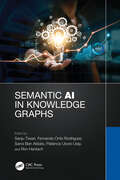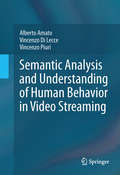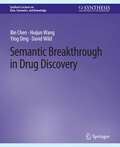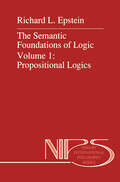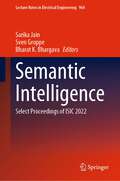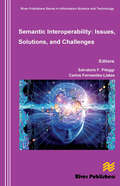- Table View
- List View
Selling on Amazon For Dummies
by Joseph Kraynak Deniz OlmezSell on Amazon and Make Them Do the Heavy Lifting Selling on Amazon has become one of the most popular ways to earn income online. In fact, there are over 2 million people selling on Amazon worldwide. Amazon allows any business, no matter how small, to get their products in front of millions of customers and take advantage of the largest fulfillment network in the world. It also allows businesses to leverage their first-class customer service and storage capabilities. Selling on Amazon For Dummies walks owners through the process of building a business on Amazon—a business that can be built almost anywhere in the world, as long as you have access to a computer and the internet. The basics of selling on Amazon Using FBA Getting started Deciding what to sell Conducting product research Finding your way around Seller Central Product sourcing, shipping and returns, Amazon subscription, fees, sales tax, and more How to earn ROIs (Returns on Your Investments) Selling on Amazon provides the strategies, tools, and education you need, including turnkey solutions focused on sales, marketing, branding, and marketplace development to analyze and maximize opportunities.
Selling on Amazon For Dummies
by Joseph Kraynak Deniz OlmezSell on Amazon and Make Them Do the Heavy Lifting Selling on Amazon has become one of the most popular ways to earn income online. In fact, there are over 2 million people selling on Amazon worldwide. Amazon allows any business, no matter how small, to get their products in front of millions of customers and take advantage of the largest fulfillment network in the world. It also allows businesses to leverage their first-class customer service and storage capabilities. Selling on Amazon For Dummies walks owners through the process of building a business on Amazon—a business that can be built almost anywhere in the world, as long as you have access to a computer and the internet. The basics of selling on Amazon Using FBA Getting started Deciding what to sell Conducting product research Finding your way around Seller Central Product sourcing, shipping and returns, Amazon subscription, fees, sales tax, and more How to earn ROIs (Returns on Your Investments) Selling on Amazon provides the strategies, tools, and education you need, including turnkey solutions focused on sales, marketing, branding, and marketplace development to analyze and maximize opportunities.
Semantic 3D Object Maps for Everyday Robot Manipulation (Springer Tracts in Advanced Robotics)
by Radu Bogdan RusuThe book written by Dr. Radu B. Rusu presents a detailed description of 3D Semantic Mapping in the context of mobile robot manipulation. As autonomous robotic platforms get more sophisticated manipulation capabilities, they also need more expressive and comprehensive environment models that include the objects present in the world, together with their position, form, and other semantic aspects, as well as interpretations of these objects with respect to the robot tasks. The book proposes novel 3D feature representations called Point Feature Histograms (PFH), as well as a frameworks for the acquisition and processing of Semantic 3D Object Maps with contributions to robust registration, fast segmentation into regions, and reliable object detection, categorization, and reconstruction. These contributions have been fully implemented and empirically evaluated on different robotic systems, and have been the original kernel to the widely successful open-source project the Point Cloud Library (PCL) -- see http://pointclouds.org.
Semantic Acquisition Games: Harnessing Manpower for Creating Semantics
by Jakub Šimko Mária BielikováMany applications depend on the effective acquisition of semantic metadata, and this state-of-the-art volume provides extensive coverage of the field of semantics acquisition games (SAGs). SAGs are a part of the crowdsourcing approach family and the authors analyze their role as tools for acquisition of resource metadata and domain models. Three case studies of SAG-based semantics acquisition methods are shown, along with other existing SAGs: 1. the Little Search Game - a search query formulation game using negative search, serving for acquisition of lightweight semantics. 2. the PexAce - a card game acquiring annotations to images. 3. the CityLights - a SAG used for validation of music metadata. The authors also look at the SAGs from their design perspectives covering SAG design issues and existing patterns, including several novel patterns. For solving cold start problems, a “helper artifact” scheme is presented, and for dealing with malicious player behavior, a posteriori cheating detection scheme is given. The book also presents methods for assessing information about player expertise, which can be used to make SAGs more effective in terms of useful output.
Semantic Agent Systems: Foundations and Applications (Studies in Computational Intelligence #344)
by Atilla Elci Mamadou Tadiou Koné Mehmet A. OrgunSemantic agent systems are about the integration of the semantic Web, software agents, and multi-agent systems technologies. Like in the past (e.g. biology and informatics yielding bioinformatics) a whole new perspective is emerging with semantic agent systems. In this context, the semantic Web is a Web of semantically linked data which aims to enable man and machine to execute tasks in tandem. Here, software agents in a multi-agent system as delegates of humans are endowed with power to use semantically linked data. This edited book “Semantic Agent Systems: Foundations and Applications” proposes contributions on a wide range of topics on foundations and applications written by a selection of international experts. It first introduces in an accessible style the nature of semantic agent systems. Then it explores with numerous illustrations new frontiers in software agent technology. “Semantic Agent Systems: Foundations and Applications” is recommended for scientists, experts, researchers, and learners in the field of artificial intelligence, the semantic Web, software agents, and multi-agent systems technologies.
Semantic AI in Knowledge Graphs
by Sanju Tiwari Fernando Ortíz-Rodriguez Sarra Ben Abbés Patience Usoro Usip Rim HantachRecent combinations of semantic technology and artificial intelligence (AI) present new techniques to build intelligent systems that identify more precise results. Semantic AI in Knowledge Graphs locates itself at the forefront of this novel development, uncovering the role of machine learning to extend the knowledge graphs by graph mapping or corpus-based ontology learning. Securing efficient results via the combination of symbolic AI and statistical AI such as entity extraction based on machine learning, text mining methods, semantic knowledge graphs, and related reasoning power, this book is the first of its kind to explore semantic AI and knowledge graphs. A range of topics are covered, from neuro-symbolic AI, explainable AI and deep learning to knowledge discovery and mining, and knowledge representation and reasoning. A trailblazing exploration of semantic AI in knowledge graphs, this book is a significant contribution to both researchers in the field of AI and data mining as well as beginner academicians.
Semantic AI in Knowledge Graphs
Recent combinations of semantic technology and artificial intelligence (AI) present new techniques to build intelligent systems that identify more precise results. Semantic AI in Knowledge Graphs locates itself at the forefront of this novel development, uncovering the role of machine learning to extend the knowledge graphs by graph mapping or corpus-based ontology learning. Securing efficient results via the combination of symbolic AI and statistical AI such as entity extraction based on machine learning, text mining methods, semantic knowledge graphs, and related reasoning power, this book is the first of its kind to explore semantic AI and knowledge graphs. A range of topics are covered, from neuro-symbolic AI, explainable AI and deep learning to knowledge discovery and mining, and knowledge representation and reasoning. A trailblazing exploration of semantic AI in knowledge graphs, this book is a significant contribution to both researchers in the field of AI and data mining as well as beginner academicians.
Semantic Analysis and Understanding of Human Behavior in Video Streaming
by Alberto Amato Vincenzo Di Lecce Vincenzo PiuriSemantic Analysis and Understanding of Human Behaviour in Video Streaming investigates the semantic analysis of the human behaviour captured by video streaming, and introduces both theoretical and technological points of view. Video analysis based on the semantic content is in fact still an open issue for the computer vision research community, especially when real-time analysis of complex scenes is concerned. This book explores an innovative, original approach to human behaviour analysis and understanding by using the syntactical symbolic analysis of images and video streaming described by means of strings of symbols. A symbol is associated to each area of the analyzed scene. When a moving object enters an area, the corresponding symbol is appended to the string describing the motion. This approach allows for characterizing the motion of a moving object with a word composed by symbols. By studying and classifying these words we can categorize and understand the various behaviours. The main advantage of this approach lies in the simplicity of the scene and motion descriptions so that the behaviour analysis will have limited computational complexity due to the intrinsic nature both of the representations and the related operations used to manipulate them. Besides, the structure of the representations is well suited for possible parallel processing, thus allowing for speeding up the analysis when appropriate hardware architectures are used. A new methodology for design systems for hierarchical high semantic level analysis of video streaming in narrow domains is also proposed. Guidelines to design your own system are provided in this book. Designed for practitioners, computer scientists and engineers working within the fields of human computer interaction, surveillance, image processing and computer vision, this book can also be used as secondary text book for advanced-level students in computer science and engineering.
Semantic Analysis of Verbal Collocations with Lexical Functions (Studies in Computational Intelligence #414)
by Alexander Gelbukh Olga KolesnikovaThis book is written for both linguists and computer scientists working in the field of artificial intelligence as well as to anyone interested in intelligent text processing. Lexical function is a concept that formalizes semantic and syntactic relations between lexical units. Collocational relation is a type of institutionalized lexical relations which holds between the base and its partner in a collocation. Knowledge of collocation is important for natural language processing because collocation comprises the restrictions on how words can be used together. The book shows how collocations can be annotated with lexical functions in a computer readable dictionary - allowing their precise semantic analysis in texts and their effective use in natural language applications including parsers, high quality machine translation, periphrasis system and computer-aided learning of lexica. The books shows how to extract collocations from corpora and annotate them with lexical functions automatically. To train algorithms, the authors created a dictionary of lexical functions containing more than 900 Spanish disambiguated and annotated examples which is a part of this book. The obtained results show that machine learning is feasible to achieve the task of automatic detection of lexical functions.
Semantic Applications: Methodology, Technology, Corporate Use
by Thomas Hoppe Bernhard Humm Anatol ReiboldThis book describes methodologies for developing semantic applications. Semantic applications are software applications which explicitly or implicitly use the semantics, i.e. the meaning of a domain terminology, in order to improve usability, correctness, and completeness. An example is semantic search, where synonyms and related terms are used for enriching the results of a simple text-based search. Ontologies, thesauri or controlled vocabularies are the centerpiece of semantic applications. The book includes technological and architectural best practices for corporate use. The authors are experts from industry and academia with experience in developing semantic applications.
Semantic Breakthrough in Drug Discovery (Synthesis Lectures on Data, Semantics, and Knowledge)
by Bin Chen Huijun Wang Ying Ding David WildThe current drug development paradigm---sometimes expressed as, ``One disease, one target, one drug''---is under question, as relatively few drugs have reached the market in the last two decades. Meanwhile, the research focus of drug discovery is being placed on the study of drug action on biological systems as a whole, rather than on individual components of such systems. The vast amount of biological information about genes and proteins and their modulation by small molecules is pushing drug discovery to its next critical steps, involving the integration of chemical knowledge with these biological databases. Systematic integration of these heterogeneous datasets and the provision of algorithms to mine the integrated datasets would enable investigation of the complex mechanisms of drug action; however, traditional approaches face challenges in the representation and integration of multi-scale datasets, and in the discovery of underlying knowledge in the integrated datasets. The Semantic Web, envisioned to enable machines to understand and respond to complex human requests and to retrieve relevant, yet distributed, data, has the potential to trigger system-level chemical-biological innovations. Chem2Bio2RDF is presented as an example of utilizing Semantic Web technologies to enable intelligent analyses for drug discovery.Table of Contents: Introduction / Data Representation and Integration Using RDF / Data Representation and Integration Using OWL / Finding Complex Biological Relationships in PubMed Articles using Bio-LDA / Integrated Semantic Approach for Systems Chemical Biology Knowledge Discovery / Semantic Link Association Prediction / Conclusions / References / Authors' Biographies
Semantic Computing
by Phillip C. Y. Sheu Heather Yu C. V. Ramamoorthy Arvind K. Joshi Lotfi A. ZadehPresents the state of the technology and points to future directions for semantic computing Semantic computing, a rapidly evolving interdisciplinary field, seeks to structure, design, and manipulate computer content to better satisfy the needs and intentions of users and create a more meaningful user experience. This remarkable contributed work examines the art, engineering, technology, and applications of the field. Moreover, it brings together researchers from such disciplines as natural language processing, software engineering, multimedia semantics, semantic Web, signal processing, and pattern recognition in order to provide a single source that presents the state of the technology and points to new breakthroughs on the horizon. Semantic Computing begins with an introduction that explores the concepts, technology, applications, and future of semantic computing. Next, the book is divided into four parts: Part One: Semantic Analysis Part Two: Semantic Languages and Integration Part Three: Semantic Applications Part Four: Semantic Programming and Interface As readers progress through the book, they,ll learn not only the underlying science, but also the fundamental technological building blocks of semantic computing. Moreover, they,ll discover a variety of cross-disciplinary solutions to current computing and communication problems. Throughout the book, references to the primary literature enable further investigation of each individual topic. Semantic Computing is ideal for industrial managers, researchers, and engineers seeking to design the next generation of computing systems in order to better meet user needs. It is also recommended as a textbook for senior undergraduate and graduate-level semantic computing courses.
Semantic Computing (World Scientific Encyclopedia With Semantic Computing And Ro Ser. #Vol. 2)
by Phillip Sheu Heather Yu C. V. Ramamoorthy Arvind K. Joshi Lotfi A. ZadehPresents the state of the technology and points to future directions for semantic computing Semantic computing, a rapidly evolving interdisciplinary field, seeks to structure, design, and manipulate computer content to better satisfy the needs and intentions of users and create a more meaningful user experience. This remarkable contributed work examines the art, engineering, technology, and applications of the field. Moreover, it brings together researchers from such disciplines as natural language processing, software engineering, multimedia semantics, semantic Web, signal processing, and pattern recognition in order to provide a single source that presents the state of the technology and points to new breakthroughs on the horizon. Semantic Computing begins with an introduction that explores the concepts, technology, applications, and future of semantic computing. Next, the book is divided into four parts: Part One: Semantic Analysis Part Two: Semantic Languages and Integration Part Three: Semantic Applications Part Four: Semantic Programming and Interface As readers progress through the book, they,ll learn not only the underlying science, but also the fundamental technological building blocks of semantic computing. Moreover, they,ll discover a variety of cross-disciplinary solutions to current computing and communication problems. Throughout the book, references to the primary literature enable further investigation of each individual topic. Semantic Computing is ideal for industrial managers, researchers, and engineers seeking to design the next generation of computing systems in order to better meet user needs. It is also recommended as a textbook for senior undergraduate and graduate-level semantic computing courses.
Semantic Control for the Cybersecurity Domain: Investigation on the Representativeness of a Domain-Specific Terminology Referring to Lexical Variation
by Claudia LanzaThis book presents the creation of a bilingual thesaurus (Italian and English), and its conversion into an ontology system, oriented to the Cybersecurity field of knowledge term management and the identification of a replicable method over other specialized areas of study, through computational linguistics procedures, to a statistical and qualitative measurement of the terminological coverage threshold a controlled vocabulary is able to guarantee with respect to the semantic richness proper to the domain under investigation. The volume empowers readers to compile and study significant corpora documentations to support the text mining tasks and to establish a representativeness evaluation of the information retrieved. Through a description of several techniques belonging to the field of linguistics and knowledge engineering, this monograph provides a methodological account on how to enhance and update semantic monitoring tools reflecting a specialized lexicon as that of Cybersecurity to grant a reference semantic structure for domain-sector text classification tasks. This volume is a valuable reference to scholars of corpus-based studies, terminology, ICT, documentation and librarianship studies, text processing research, and distributional semantics area of interest as well as for professionals involved in Cybersecurity organizations.
Semantic Control for the Cybersecurity Domain: Investigation on the Representativeness of a Domain-Specific Terminology Referring to Lexical Variation
by Claudia LanzaThis book presents the creation of a bilingual thesaurus (Italian and English), and its conversion into an ontology system, oriented to the Cybersecurity field of knowledge term management and the identification of a replicable method over other specialized areas of study, through computational linguistics procedures, to a statistical and qualitative measurement of the terminological coverage threshold a controlled vocabulary is able to guarantee with respect to the semantic richness proper to the domain under investigation. The volume empowers readers to compile and study significant corpora documentations to support the text mining tasks and to establish a representativeness evaluation of the information retrieved. Through a description of several techniques belonging to the field of linguistics and knowledge engineering, this monograph provides a methodological account on how to enhance and update semantic monitoring tools reflecting a specialized lexicon as that of Cybersecurity to grant a reference semantic structure for domain-sector text classification tasks. This volume is a valuable reference to scholars of corpus-based studies, terminology, ICT, documentation and librarianship studies, text processing research, and distributional semantics area of interest as well as for professionals involved in Cybersecurity organizations.
Semantic Digital Libraries
by Sebastian Ryszard Kruk Bill McDanielLibraries have always been an inspiration for the standards and technologies developed by semantic web activities. However, except for the Dublin Core specification, semantic web and social networking technologies have not been widely adopted and further developed by major digital library initiatives and projects. Yet semantic technologies offer a new level of flexibility, interoperability, and relationships for digital repositories. Kruk and McDaniel present semantic web-related aspects of current digital library activities, and introduce their functionality; they show examples ranging from general architectural descriptions to detailed usages of specific ontologies, and thus stimulate the awareness of researchers, engineers, and potential users of those technologies. Their presentation is completed by chapters on existing prototype systems such as JeromeDL, BRICKS, and Greenstone, as well as a look into the possible future of semantic digital libraries. This book is aimed at researchers and graduate students in areas like digital libraries, the semantic web, social networks, and information retrieval. This audience will benefit from detailed descriptions of both today’s possibilities and also the shortcomings of applying semantic web technologies to large digital repositories of often unstructured data.
Semantic Domains in Computational Linguistics
by Alfio Gliozzo Carlo StrapparavaSemantic fields are lexically coherent – the words they contain co-occur in texts. In this book the authors introduce and define semantic domains, a computational model for lexical semantics inspired by the theory of semantic fields. Semantic domains allow us to exploit domain features for texts, terms and concepts, and they can significantly boost the performance of natural-language processing systems. Semantic domains can be derived from existing lexical resources or can be acquired from corpora in an unsupervised manner. They also have the property of interlinguality, and they can be used to relate terms in different languages in multilingual application scenarios. The authors give a comprehensive explanation of the computational model, with detailed chapters on semantic domains, domain models, and applications of the technique in text categorization, word sense disambiguation, and cross-language text categorization. This book is suitable for researchers and graduate students in computational linguistics.
Semantic e-Science: Papers From The 2007 Aaai Workshop (Annals of Information Systems #11)
by Huajun Chen Yimin Wang Kei-Hoi CheungThe Semantic Web has been a very important development in how knowledge is disseminated and manipulated on the Web, but it has been of particular importance to the flow of scientific knowledge, and will continue to shape how data is stored and accessed in a broad range of disciplines, including life sciences, earth science, materials science, and the social sciences. After first presenting papers on the foundations of semantic e-science, including papers on scientific knowledge acquisition, data integration, and workflow, this volume looks at the state of the art in each of the above-mentioned disciplines, presenting research on semantic web applications in the life, earth, materials, and social sciences. Drawing papers from three semantic web workshops, as well as papers from several invited contributors, this volume illustrates how far semantic web applications have come in helping to manage scientific information flow.
The Semantic Foundations of Logic Volume 1: Propositional Logics (Nijhoff International Philosophy Series #35)
by R.L. EpsteinThis book grew out of my confusion. If logic is objective how can there be so many logics? Is there one right logic, or many right ones? Is there some underlying unity that connects them? What is the significance of the mathematical theorems about logic which I've learned if they have no connection to our everyday reasoning? The answers I propose revolve around the perception that what one pays attention to in reasoning determines which logic is appropriate. The act of abstracting from our reasoning in our usual language is the stepping stone from reasoned argument to logic. We cannot take this step alone, for we reason together: logic is reasoning which has some objective value. For you to understand my answers, or perhaps better, conjectures, I have retraced my steps: from the concrete to the abstract, from examples, to general theory, to further confirming examples, to reflections on the significance of the work.
Semantic Grid: Model, Methodology, and Applications (Advanced Topics in Science and Technology in China)
by Zhaohui Wu Huajun ChenSemantic Grid: Model, Methodology, and Applications introduces to the science, core technologies, and killer applications. First, scientific issues of semantic grid systems are covered, followed by two basic technical issues, data-level semantic mapping, and service-level semantic interoperating. Two killer applications are then introduced to show how to build a semantic grid for specific application domains. Although this book is organized in a step by step manner, each chapter is independent. Detailed application scenarios are also presented. In 1990, Prof. Wu invented the first KB-system tool, ZIPE, based on C on a SUN platform. He proposed the first coupling knowledge representing model, Couplingua, which embodies Rule, Frame, Semantic Network and Nerve Cell Network, and supports symbol computing and data processing computing. His current focus is on semantic web, grid & ubiquitous computing, and their applications in the life sciences.
Semantic Hyper/Multimedia Adaptation: Schemes and Applications (Studies in Computational Intelligence #418)
by Ioannis E. Anagnostopoulos Mária Bieliková Phivos Mylonas Nicolas TsapatsoulisNowadays, more and more users are witnessing the impact of Hypermedia/Multimedia as well as the penetration of social applications in their life. Parallel to the evolution of the Internet and Web, several Hypermedia/Multimedia schemes and technologies bring semantic-based intelligent, personalized and adaptive services to the end users. More and more techniques are applied in media systems in order to be user/group-centric, adapting to different content and context features of a single or a community user. In respect to all the above, researchers need to explore and study the plethora of challenges that emergent personalisation and adaptation technologies bring to the new era. This edited volume aims to increase the awareness of researchers in this area. All contributions provide an in-depth investigation on research and deployment issues, regarding already introduced schemes and applications in Semantic Hyper/Multimedia and Social Media Adaptation. Moreover, the authors provide survey-based articles, so as potential readers can use it for catching up the recent trends and applications in respect to the relevant literature. Finally, the authors discuss and present their approach in the respective field or problem addressed.
Semantic Integration of Heterogeneous Software Specifications (Monographs in Theoretical Computer Science. An EATCS Series)
by Martin Große-RhodeThe first book to integrate various model-based software specification approaches. The integration approach is based on a common semantic domain of abstract systems, their composition and development. Its applicability is shown through semantic interpretations and compositional comparisons of different specification approaches. These range from formal specification techniques like process calculi, Petri nets and rule-based formalisms to semiformal software modeling languages like those in the UML family.
Semantic Intelligence: Select Proceedings of ISIC 2022 (Lecture Notes in Electrical Engineering #964)
by Sarika Jain Sven Groppe Bharat K. BhargavaThis book constitutes refereed proceedings of the 2nd International Semantic Intelligence Conference (ISIC 2022). This book covers a wide range of topics, including semantic web engineering, ontology-based data access, multimodal and multilingual access, machine-to-machine communications and interoperability, knowledge extraction and ontology learning from the web, computational paradigms and computational intelligence, distributed and mobile systems, and many others. This book includes novel contributions and the latest developments from researchers across industry and academia. This book serves as a valuable reference resource for academics and researchers across the globe.
Semantic Interaction for Visual Analytics: Inferring Analytical Reasoning for Model Steering (Synthesis Lectures on Visualization)
by Alex EndertThis book discusses semantic interaction, a user interaction methodology for visual analytic applications that more closely couples the visual reasoning processes of people with the computation. This methodology affords user interaction on visual data representations that are native to the domain of the data. User interaction in visual analytics systems is critical to enabling visual data exploration. Interaction transforms people from mere viewers to active participants in the process of analyzing and understanding data. This discourse between people and data enables people to understand aspects of their data, such as structure, patterns, trends, outliers, and other properties that ultimately result in insight. Through interacting with visualizations, users engage in sensemaking, a process of developing and understanding relationships within datasets through foraging and synthesis.The book provides a description of the principles of semantic interaction, providing design guidelines for the integration of semantic interaction into visual analytics, examples of existing technologies that leverage semantic interaction, and a discussion of how to evaluate these technologies. Semantic interaction has the potential to increase the effectiveness of visual analytic technologies and opens possibilities for a fundamentally new design space for user interaction in visual analytics systems.
Semantic Interoperability Issues, Solutions, Challenges
by Salvatore F. Pileggi Carlos Fernandez-LlatasSemantic technologies are experimenting an increasing popularity in the context of different domains and applications. The understanding of any class of system can be significantly changed under the assumption any system is part of a global ecosystem known as Semantic Web.The Semantic Web would be an evolving extension of current Web model (normally referred as Syntactic Web) that introduces a semantic layer in which semantics, or meaning of information, are formally defined.So, semantics should integrate web-centric standard information infrastructures improving several aspects of interaction among heterogeneous systems. This is because common interoperability models are progressively becoming obsolete if compared with the intrinsic complexity and always more distributed focus that feature modern systems. For example, the basic interoperability model, that assumes the interchange of messages among systems without any interpretation, is simple but effective only in the context of close environments. Also more advanced models, such as the functional interoperability model that integrates basic interoperability model with the ability of intepretating data context under the assumption of a shared schema for data fields accessing, appears not able to provide a full sustainable technologic support for open systems.The Semantic Interoperability model would improve common interoperability models introducing the interpretation of means of data. Semantic interoperability is a concretely applicable interaction model under the assumption of adopting rich data models (commonly called Ontology) composed of concepts within a domain and the relationships among those concepts.In practice, semantic technologies are partially inverting the common view at actor intelligence: intelligence is not implemented (only) by actors but it is implicitly resident in the knowledge model. In other words, schemas contain information and the "code" to interpretate it.




